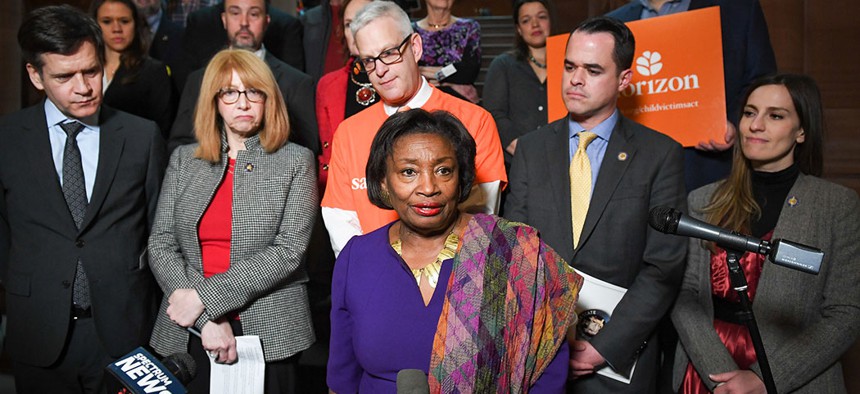New York State
Child Victims Act leads to insurance woes
Some institutions facing or at risk of facing child sex abuse lawsuits have lost coverage.

State Senate Majority Leader Andrea Stewart-Cousins speaks at a press conference to mark the one year anniversary of the passage of the Child Victims Act on Jan. 28. NY Senate Media Services
About six months into the implementation of the Child Victims Act, more than 1,400 child sex abuse cases have been filed in New York. The law – which provides a one-year window for people to bring forward such lawsuits regardless of the statute of limitations – has resulted in a flood of lawsuits against Catholic Church in particular. The Roman Catholic Diocese of Rochester filed for bankruptcy in the aftermath of the law’s implementation – which victims’ advocates argued allowed it to bypass scrutiny for the alleged crimes – with the Buffalo Diocese expected to follow suit soon.
But the law’s financial and logistical challenges have affected many other institutions, such as schools and nonprofits, who have faced increased insurance costs and difficulties finding old insurance providers as they confront lawsuits regarding crimes dating back decades. Some have lost coverage for sexual abuse altogether.
“What’s happening is that insurance policies from this point forward are excluding this risk from the policy,” Robert Chesler, an attorney at Anderson Kill who represents insurance policyholders, told City & State.
Insurers set aside reserves based on what they expect to pay on future claims, often using the statute of limitations to inform those estimates. When New York and other states began to extend or remove those restrictions on filing child sexual abuse cases, insurers had to recalculate. That has led to many carriers increasing the cost of taking on policies covering those cases, imposing prerequistes for getting covering – such as implementing sexual abuse trainings – and, in some cases, no longer covering them altogether, Chesler said. This is important for organizations facing lawsuits, who may otherwise be on the hook for the full cost of legal defense and settlements.
Bill Gettman, who runs the foster care provider Northern Rivers Family Services, said the cost of his organization’s insurance policy covering molestation has gone up 10% despite his nonprofit organization facing no allegations currently. The nonprofit’s insurer, Philadelphia Insurance Companies, did not respond to questions about whether that policy increased in response to the Child Victims Act.
One of the ongoing difficulties for institutions facing allegations dating back decades is figuring out what insurance policies they held then, often enlisting the services of a so-called insurance archeologist to find out what coverage they had.
“We began to say, do we have a list of all our insurers going back to the early 1900s,” Gettman said regarding his 190-year-old organization in the wake of the law’s passage. “I don’t know about your record-keeping, but we did not have a master or comprehensive list in terms of all the companies that insured us and our affiliates.”
The governor’s office has provided a list of inactive and active insurers dating back to 1960 for organizations to more easily find that out, although it still often requires having a forensic professional comb through internal records or interview old staff members to find the right carrier.
“The kinds of policyholders that are facing these claims now, many of them are very small, and so finding the insurance is absolutely critical for any years where they’re facing allegations about sexual abuse,” said Sheila Mulrennan, founder and president of the Insurance Archeaology Group.
The Children’s Village, a child welfare nonprofit that faces two claims of child sexual abuse dating back to the mid-1970s, continues to struggle to find its older records and insurance policies as well, particularly because its entire administrative building burned down in 1994, President and CEO Jeremy Kohomban told City & State.
“This is before electronic records, so we really have nothing from those years,” he said. “Witnesses are impossible to track down. Many are dead because they’re older than the children, and it’s been really challenging to get into the forensics of the claim.”
Even when an organization does know its insurer, many policies going back several decades didn’t cover sexual abuse claims. And when they did, insurers often raise every issue they can to dispute coverage, Mulrennan said.
These concerns go beyond private institutions as well. Schools districts, which legally cannot go bankrupt in New York, have faced similar issues with insurance, said Jay Worona, deputy executive director and general counsel for the New York State School Boards Association.
All the representatives of organizations at risk of or currently facing lawsuits told City & State they support the law’s ultimate goal of providing justice to survivors of child sexual abuse – they said they just want it to implemented better.
“Our primary message is: We want to undo the hurt as best we can,” Kohomban said.
NEXT STORY: What to know about this weekend’s NYPD shootings

